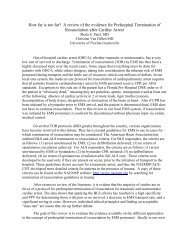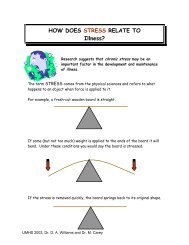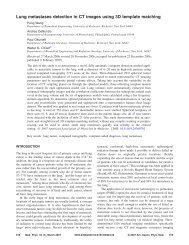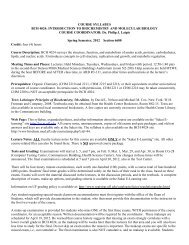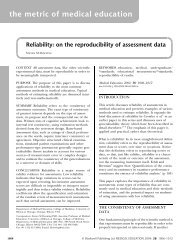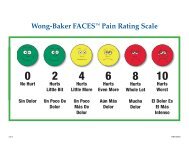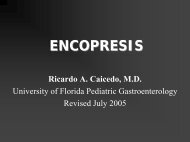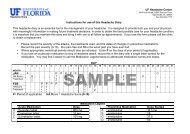imaging three-dimensional cardiac function - Walter G. O'Dell, PhD
imaging three-dimensional cardiac function - Walter G. O'Dell, PhD
imaging three-dimensional cardiac function - Walter G. O'Dell, PhD
Create successful ePaper yourself
Turn your PDF publications into a flip-book with our unique Google optimized e-Paper software.
Annu. Rev. Biomed. Eng. 2000.2:431-456. Downloaded from arjournals.annualreviews.orgby UNIVERSITY OF ROCHESTER LIBRARY on 07/27/09. For personal use only.?IMAGING 3-D CARDIAC FUNCTION 447are needed. However, for the complex, 3-D heart wall motion, with high-ordertransmural gradients in the displacement field and spatial heterogeneity (i.e. fromseptum to free wall and base to apex), many global degrees of freedom are requiredto describe the motion around a given material point.To describe the trajectory and strain environment of a given material point (e.g.to within 0.3-mm 3-D tracking accuracy) requires many parameters in a localdeformation model or perhaps >100 in a global model. However, the resolutionand accuracy one actually needs for a given purpose may be considerably lessstringent. Models based on a priori assumptions and a few simple expected modesmay give sufficient information in an efficient manner.Upon successful image segmentation, a typical MRI parallel-tagging data setgenerates 3000–10,000 samples of 1-D displacement. Points along tag lines areobtained typically at 1- or 2-mm intervals. In the clinical setting, the separationbetween tags is typically 6–7 mm, the distance between contiguous image slicesis often 7–10 mm, and hence the 3-mm sampling criterion estimated by Douglaset al (61) is not met in all directions. Experimental conditions, however, can affordgreater image quality and spatial resolution and can overcome these limitations.The ultimate clinical goal of 3-D <strong>cardiac</strong> deformation analysis is to quantify andcharacterize regions of altered mechanical <strong>function</strong>. Figure 3 (see color insert)compares subendocardial and subepicardial circumferential strains at end-systole(referenced to end-diastole) in a patient with LV anterior-wall dys<strong>function</strong> thatis secondary to ischemia. This region is typically supplied by the LAD coronaryartery; therefore, we can postulate that there is a critical occlusion of that artery.In the central ischemic zone, the circumferential strain is positive, indicating thatthe region is undergoing stretch or bulging in response to the contraction of theneighboring healthy tissue and the imposed cavity pressure.For clinical application, the primary concern is whether the tissue is viable. Ifthe tissue were necrotic, then an aggressive and expensive treatment paradigm,e.g. open-chest coronary graft surgery, would not be beneficial. However, if it canbe shown that the tissue is yet viable, then restoration of normal circulation willpresumably restore normal <strong>cardiac</strong> <strong>function</strong>. The secondary issue is to quantify thedegree of dys<strong>function</strong>. A patient exhibiting only a 20% loss of contractile <strong>function</strong>can perhaps be treated with a less aggressive, less expensive pharmacologicregimen, whereas a patient with an 80% loss of regional <strong>function</strong> will perhapsneed more immediate aggressive therapy, such as balloon angioplasty, to restorevascular patency.Dobutamine or adenosine stress testing has been suggested for noninvasive detectionof viable but noncontracting (hibernating) myocardium in conjunction withMRI motion tracking. Croisille et al (92) found improved <strong>function</strong> in response toREGIONAL STRAINS IN DISEASE



